Monitoring of Carbon Stocks in Pastures in the Savannas of Brazil through Ecosystem Modeling on a Regional Scale
Abstract
1. Introduction
2. Materials and Methods
2.1. Study Area
2.2. CENTURY Model
2.3. Sites to Model Calibration and Validation
2.4. Pasture Ages
2.5. Weather Data
2.6. Soil Physicochemical Properties
2.7. CENTURY Model Parameterization
2.8. Model Performance Analysis
3. Results
3.1. Performance Evaluation of the CENTURY Model Per Site
3.2. Prediction of C stocks in Cerrado Pastures on a Regional Scale
3.3. Effect of Soil Type and Age of Pastures on Carbon Stocks
3.4. Monitoring C Stocks in Cerrado Pastures
4. Conclusions
Supplementary Materials
Author Contributions
Funding
Data Availability Statement
Acknowledgments
Conflicts of Interest
References
- Peters, G.P.; Andrew, R.M.; Boden, T.; Canadell, J.G.; Ciais, P.; Le Quéré, C.; Marland, G.; Raupach, M.R.; Wilson, C. The Challenge to Keep Global Warming below 2 °C. Nat. Clim. Chang. 2013, 3, 4–6. [Google Scholar] [CrossRef]
- Houghton, R.A. Balancing the Global Carbon Budget. Annu. Rev. Earth Planet. Sci. 2007, 35, 313–347. [Google Scholar] [CrossRef]
- Friedlingstein, P.; O’Sullivan, M.; Jones, M.W.; Andrew, R.M.; Hauck, J.; Olsen, A.; Peters, G.P.; Peters, W.; Pongratz, J.; Sitch, S.; et al. Global Carbon Budget 2020. Earth Syst. Sci. Data 2020, 12, 3269–3340. [Google Scholar] [CrossRef]
- Albuquerque, I.; Alencar, A.; Angelo, C. Analysis of Brazilian greenhouse gas emissions and their implications for Brazil’s climate goals 1970–2019. 2020, 1, p. 41. Available online: https://energiaeambiente.org.br/produto/analise-das-emissoes-brasileiras-de-gases-de-efeito-estufa-e-suas-implicacoes-para-as-metas-climaticas-do-brasil-1970-2020 (accessed on 6 November 2022).
- SEEG Greenhouse Gas Emission Estimation System. Available online: https://plataforma.seeg.eco.br/total_emission (accessed on 10 February 2022).
- Cerri, C.E.P.; Paustian, K.; Bernoux, M.; Victoria, R.L.; Melillo, J.M.; Cerri, C.C. Modeling Changes in Soil Organic Matter in Amazon Forest to Pasture Conversion with the Century Model. Soil Tillage Res. 2004, 10, 815–832. [Google Scholar] [CrossRef]
- Bustamante, M.M.C.; Nobre, C.A.; Smeraldi, R.; Aguiar, A.P.D.; Barioni, L.G.; Ferreira, L.G.; Longo, K.; May, P.; Pinto, A.S.; Ometto, J.P.H.B. Estimating Greenhouse Gas Emissions from Cattle Raising in Brazil. Clim. Chang. 2012, 115, 559–577. [Google Scholar] [CrossRef]
- Dias-Filho, M.B. Diagnosis of Pastures in Brazil; Embrapa Eastern Amazon: Belém, Brazil, 2014; p. 36. [Google Scholar]
- Pereira, O.; Ferreira, L.; Pinto, F.; Baumgarten, L. Assessing Pasture Degradation in the Brazilian Cerrado Based on the Analysis of MODIS NDVI Time-Series. Remote Sens. 2018, 10, 1761. [Google Scholar] [CrossRef]
- Henderson, B.B.; Gerber, P.J.; Hilinski, T.E.; Falcucci, A.; Ojima, D.S.; Salvatore, M.; Conant, R.T. Greenhouse Gas Mitigation Potential of the World’s Grazing Lands: Modeling Soil Carbon and Nitrogen Fluxes of Mitigation Practices. Agric. Ecosyst. Environ. 2015, 207, 91–100. [Google Scholar] [CrossRef]
- Smith, P.; Smith, J.U.; Powlson, D.S.; McGill, W.B.; Arah, J.R.M.; Chertov, O.G.; Coleman, K.; Franko, U.; Frolking, S.; Jenkinson, D.S.; et al. A Comparison of the Performance of Nine Soil Organic Matter Models Using Datasets from Seven Long-Term Experiments. Geoderma 1997, 81, 153–225. [Google Scholar] [CrossRef]
- Parton, W.J.; Schimel, D.S.; Cole, C.V.; Ojima, D.S. Analysis of Factors Controlling Soil Organic Matter Levels in Great Plains Grasslands. Soil Sci. Soc. Am. J. 1987, 51, 1173–1179. [Google Scholar] [CrossRef]
- Tornquist, C.G.; Mielniczuk, J.; Cerri, C.E.P. Modeling Soil Organic Carbon Dynamics in Oxisols of Ibirubá (Brazil) with the Century Model. Soil Tillage Res. 2009, 105, 33–43. [Google Scholar] [CrossRef]
- Vezzani, F.M.; Mielniczuk, J. Aggregation and carbon stock in an argisol submitted to different agricultural management practices. Rev. Bras. Ciênc. Solo 2011, 35, 213–223. [Google Scholar] [CrossRef]
- Bortolon, E.S.O.; Mielniczuk, J.; Tornquist, C.G.; Lopes, F.; Bergamaschi, H. Validation of the Century Model to Estimate the Impact of Agriculture on Soil Organic Carbon in Southern Brazil. Geoderma 2011, 167, 156–166. [Google Scholar] [CrossRef]
- Brandani, C.B.; Abbruzzini, T.F.; Williams, S.; Easter, M.; Pellegrino Cerri, C.E.; Paustian, K. Simulation of Management and Soil Interactions Impacting SOC Dynamics in Sugarcane Using the CENTURY Model. GCB Bioenergy 2015, 7, 646–657. [Google Scholar] [CrossRef]
- Ouyang, W.; Shan, Y.; Hao, F.; Lin, C. Differences in Soil Organic Carbon Dynamics in Paddy Fields and Drylands in Northeast China Using the CENTURY Model. Agric. Ecosyst. Environ. 2014, 194, 38–47. [Google Scholar] [CrossRef]
- Parente, L.; Mesquita, V.; Miziara, F.; Baumann, L.; Ferreira, L. Assessing the Pasturelands and Livestock Dynamics in Brazil, from 1985 to 2017: A Novel Approach Based on High Spatial Resolution Imagery and Google Earth Engine Cloud Computing. Remote Sens. Environ. 2019, 232, 111301. [Google Scholar] [CrossRef]
- Souza, C.M.; Shimbo, J.Z.; Rosa, M.R.; Parente, L.L.; Alencar, A.A.; Rudorff, B.F.T.; Hasenack, H.; Matsumoto, M.; Ferreira, L.G.; Souza-Filho, P.W.M.; et al. Reconstructing Three Decades of Land Use and Land Cover Changes in Brazilian Biomes with Landsat Archive and Earth Engine. Remote Sens. 2020, 12, 2735. [Google Scholar] [CrossRef]
- Oliveira-Filho, A.T.; Ratter, J.A. Vegetation Physiognomies and Woody Flora of the Cerrado Biome; Columbia University Press: New York, NY, USA, 2002; pp. 91–120. [Google Scholar]
- Assad, E.D.; Pinto, H.S.; Martins, S.C.; Groppo, J.D.; Salgado, P.R.; Evangelista, B.; Vasconcellos, E.; Sano, E.E.; Pavão, E.; Luna, R.; et al. Changes in Soil Carbon Stocks in Brazil Due to Land Use: Paired Site Comparisons and a Regional Pasture Soil Survey. Biogeosciences 2013, 10, 6141–6160. [Google Scholar] [CrossRef]
- Pinto, P.H.P.; Souza, L.B.; Zavattini, J.A. The Correction of Failures and Selection of Classes for Pluviometric Data Interpolation. Simpósio Bras. Climatol. Geográfica 2016, 12, 13–19. [Google Scholar]
- Abatzoglou, J.T.; Dobrowski, S.Z.; Parks, S.A.; Hegewisch, K.C. TerraClimate, a High-Resolution Global Dataset of Monthly Climate and Climatic Water Balance from 1958–2015. Sci. Data 2018, 5, 170191. [Google Scholar] [CrossRef]
- de Carvalho, A.L.; Menezes, R.S.C.; Nóbrega, R.S.; de Siqueira Pinto, A.; Ometto, J.P.H.B.; von Randow, C.; Giarolla, A. Impact of Climate Changes on Potential Sugarcane Yield in Pernambuco, Northeastern Region of Brazil. Renew. Energy 2015, 78, 26–34. [Google Scholar] [CrossRef]
- Hengl, T.; de Jesus, J.M.; MacMillan, R.A.; Batjes, N.H.; Heuvelink, G.B.M.; Ribeiro, E.; Samuel-Rosa, A.; Kempen, B.; Leenaars, J.G.B.; Walsh, M.G.; et al. SoilGrids1km—Global Soil Information Based on Automated Mapping. PLoS ONE 2014, 9, e105992. [Google Scholar] [CrossRef] [PubMed]
- Batjes, N.H.; Ribeiro, E.; van Oostrum, A. Standardised Soil Profile Data to Support Global Mapping and Modelling (WoSIS Snapshot 2019). Earth Syst. Sci. Data 2020, 12, 299–320. [Google Scholar] [CrossRef]
- Ferreira, E.A.B. Long-Term Dynamics of Soil Carbon in Management Systems in the Cerrado. Ph.D. Thesis, University of Brasilia, Brasília, Brazil, 2013. [Google Scholar]
- Silva, J.R. Carbon Dynamics in Soils under Pasture Areas in the Cerrado Biome. Ph.D. Thesis, Federal University of Goiás, Goiânia, Brazil, 2019. [Google Scholar]
- Oliveira, E.S.; Reatto, A.; Roig, H.L. Soil carbon stocks according to landscape components. Cad. de Ciência Tecnol. 2015, 32, 71–93. [Google Scholar]
- Oliveira, L.B.T.D.; Santos, A.C.D.; Lima, J.D.S.; Neves Neto, D.N. Spatial variability of productive and morphological responses of marandu grass as a function of chemical and topographic attributes. Rev. Bras. Saúde Prod. Anim. 2015, 16, 772–783. [Google Scholar] [CrossRef][Green Version]
- Dias-Filho, M.B. Pasture Degradation: Processes, Causes and Recovery Strategies, 4th ed.; MBDF: Belém, Brazil, 2011. [Google Scholar]
- Nash, J.E.; Sutcliffe, J.V. River Flow Forecasting through Conceptual Models Part I—A Discussion of Principles. J. Hydrol. 1970, 10, 282–290. [Google Scholar] [CrossRef]
- Parton, W.J.; Scurlock, J.M.O.; Ojima, D.S.; Gilmanov, T.G.; Scholes, R.J.; Schimel, D.S.; Kirchner, T.; Menaut, J.-C.; Seastedt, T.; Garcia Moya, E.; et al. Observations and Modeling of Biomass and Soil Organic Matter Dynamics for the Grassland Biome Worldwide. Glob. Biogeochem. Cycles 1993, 7, 785–809. [Google Scholar] [CrossRef]
- Silva-Olaya, A.M.; Cerri, C.E.P.; Williams, S.; Cerri, C.C.; Davies, C.A.; Paustian, K. Modelling SOC Response to Land Use Change and Management Practices in Sugarcane Cultivation in South-Central Brazil. Plant Soil 2017, 410, 483–498. [Google Scholar] [CrossRef]
- Fidalgo, E.C.C.; Benites, V.D.M.; Machado, P.L.O.D.A.; Madari, B.E.; Coelho, M.R.; de Moura, I.B.; de Lima, C.X. Carbon stock in Brazilian soils. Embrapa Solos-Bol. de Pesqui. E Desenvolv. 2007, 121, 1–27. [Google Scholar]
- Carvalho, J.L.N.; Raucci, G.S.; Cerri, C.E.P.; Bernoux, M.; Feigl, B.J.; Wruck, F.J.; Cerri, C.C. Impact of Pasture, Agriculture and Crop-Livestock Systems on Soil C Stocks in Brazil. Soil Tillage Res. 2010, 110, 175–186. [Google Scholar] [CrossRef]
- Braz, S.P.; Urquiaga, S.; Alves, B.J.R.; Jantalia, C.P.; Guimarães, A.P.; dos Santos, C.A.; dos Santos, S.C.; Pinheiro, É.F.M.; Boddey, R.M. Soil Carbon Stocks under Productive and Degraded Brachiaria Pastures in the Brazilian Cerrado. Soil Sci. Soc. Am. J. 2013, 77, 914–928. [Google Scholar] [CrossRef]
- Santos, C.O. Ecosystemic and Functional Characterization of Brazilian Pastures. Ph.D. Thesis, Federal University of Goiás, Goiania, Brazil, 2021. [Google Scholar]
- Didan, K.; Munoz, A.B.; Huete, A. MODIS Vegetation Index User’s Guide (MOD13 Series Version 3.0 Collection 6); The University of Arizona: Tucson, AZ, USA, 2015; p. 35. [Google Scholar]
- Running, S.W.; Zhao, M. Daily GPP and Annual NPP (MOD17A2/A3) Products NASA Earth Observing System MODIS Land Algorithm (User’s Guide V3). In User’s Guide; MODIS Land Team NASA: Washington, DC, USA, 2015; p. 28. [Google Scholar]
- Gomes, L.C.; Faria, R.M.; de Souza, E.; Veloso, G.V.; Schaefer, C.E.G.R.; Filho, E.I.F. Modelling and Mapping Soil Organic Carbon Stocks in Brazil. Geoderma 2019, 340, 337–350. [Google Scholar] [CrossRef]
- Corbeels, M.; Marchão, R.L.; Neto, M.S.; Ferreira, E.G.; Madari, B.E.; Scopel, E.; Brito, O.R. Evidence of Limited Carbon Sequestration in Soils under No-Tillage Systems in the Cerrado of Brazil. Sci. Rep. 2016, 6, 21450. [Google Scholar] [CrossRef]
- Carvalho, W.T.V.; Minighin, D.C.; Gonçalves, L.C.; Villanova, D.F.Q.; Mauricio, R.M.; Pereira, R.V.G. Degraded pastures and recovery techniques: Review. Pubvet 2017, 11, 1036–1045. [Google Scholar] [CrossRef]
- Baccini, A.; Goetz, S.J.; Walker, W.S.; Laporte, N.T.; Sun, M.; Sulla-Menashe, D.; Hackler, J.; Beck, P.S.A.; Dubayah, R.; Friedl, M.A.; et al. Estimated Carbon Dioxide Emissions from Tropical Deforestation Improved by Carbon-Density Maps. Nat. Clim. Chang. 2012, 2, 182–185. [Google Scholar] [CrossRef]
- Englund, O.; Sparovek, G.; Berndes, G.; Freitas, F.; Ometto, J.P.; Oliveira, P.V.D.C.E.; Costa, C.; Lapola, D. A New High-Resolution Nationwide Aboveground Carbon Map for Brazil. Geo Geogr. Environ. 2017, 4, e00045. [Google Scholar] [CrossRef]
- Ometto, J.P.; Aguiar, A.P.; Assis, T.; Soler, L.; Valle, P.; Tejada, G.; Lapola, D.M.; Meir, P. Amazon Forest Biomass Density Maps: Tackling the Uncertainty in Carbon Emission Estimates. Clim. Chang. 2014, 124, 545–560. [Google Scholar] [CrossRef]
- Saatchi, S.S.; Harris, N.L.; Brown, S.; Lefsky, M.; Mitchard, E.T.A.; Salas, W.; Zutta, B.R.; Buermann, W.; Lewis, S.L.; Hagen, S.; et al. Benchmark Map of Forest Carbon Stocks in Tropical Regions across Three Continents. Proc. Natl. Acad. Sci. USA 2011, 108, 9899–9904. [Google Scholar] [CrossRef]
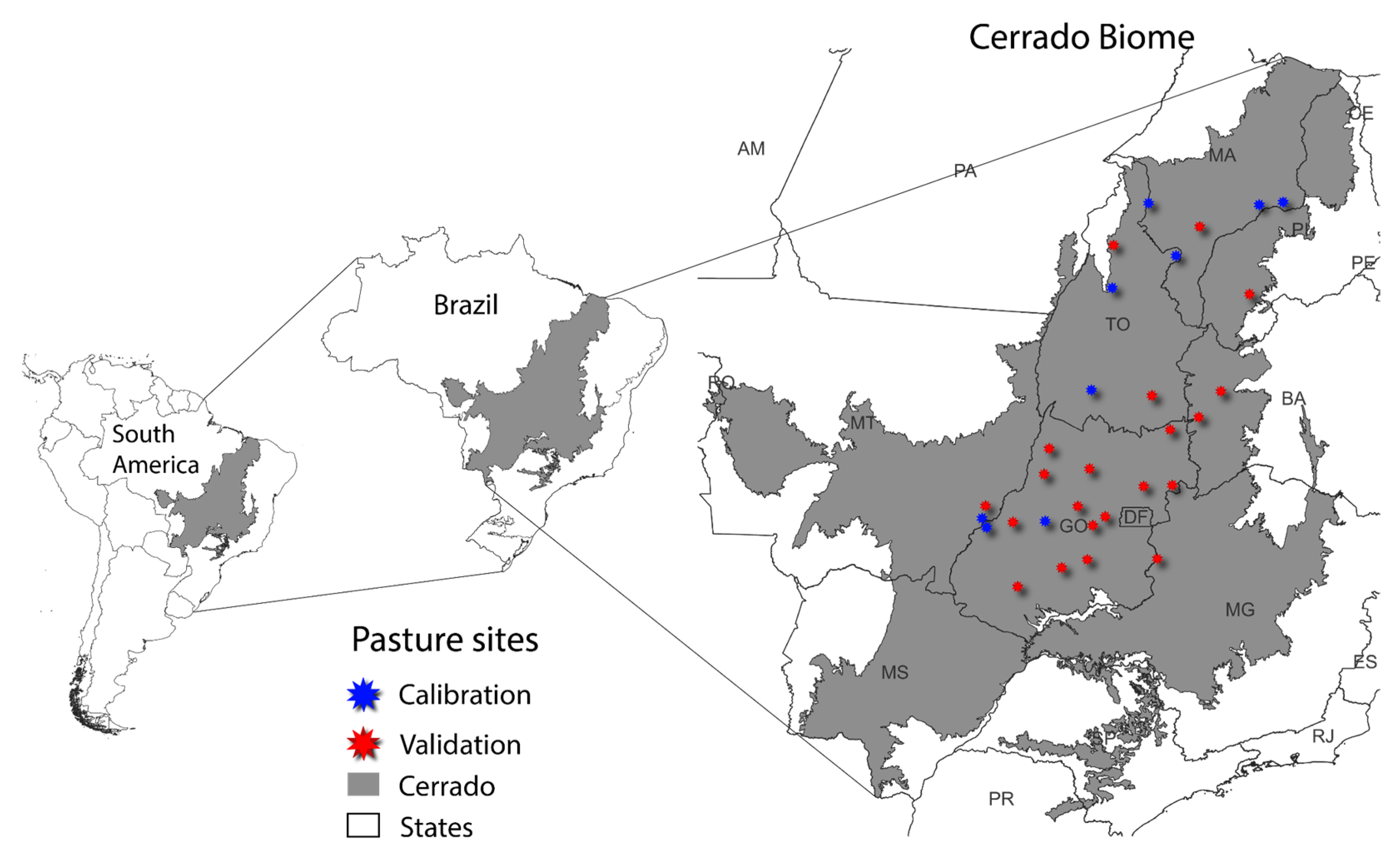
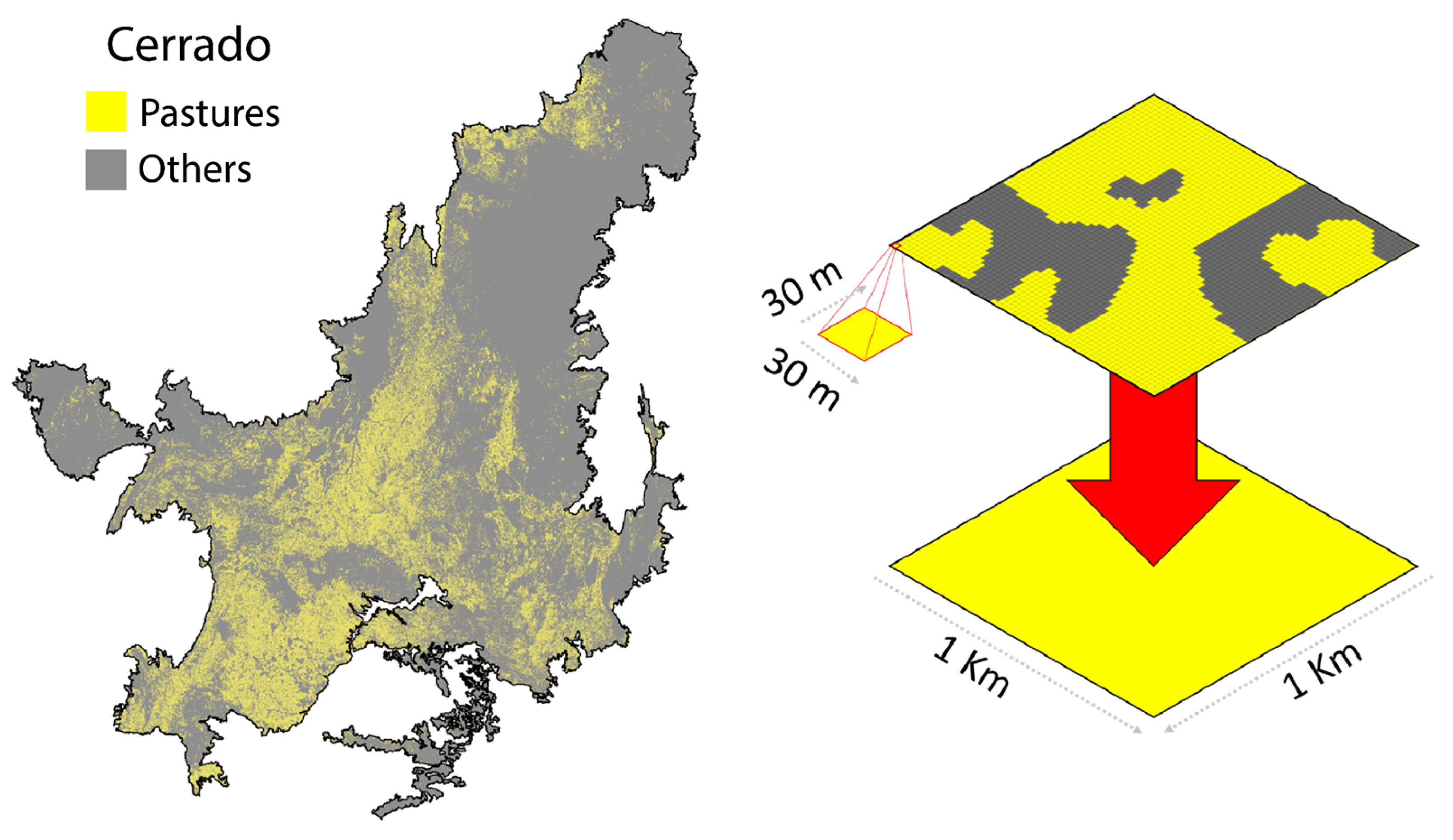
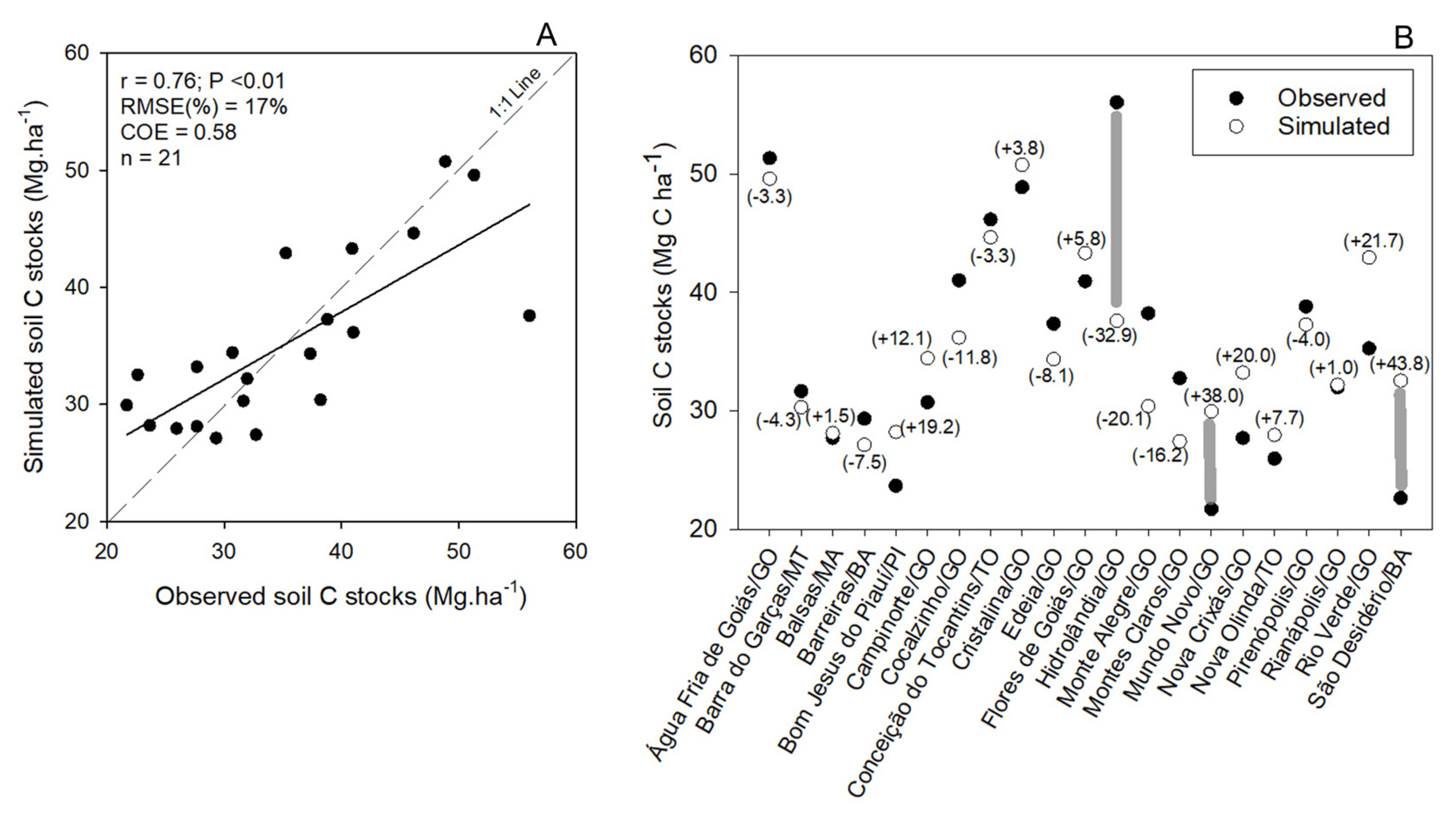
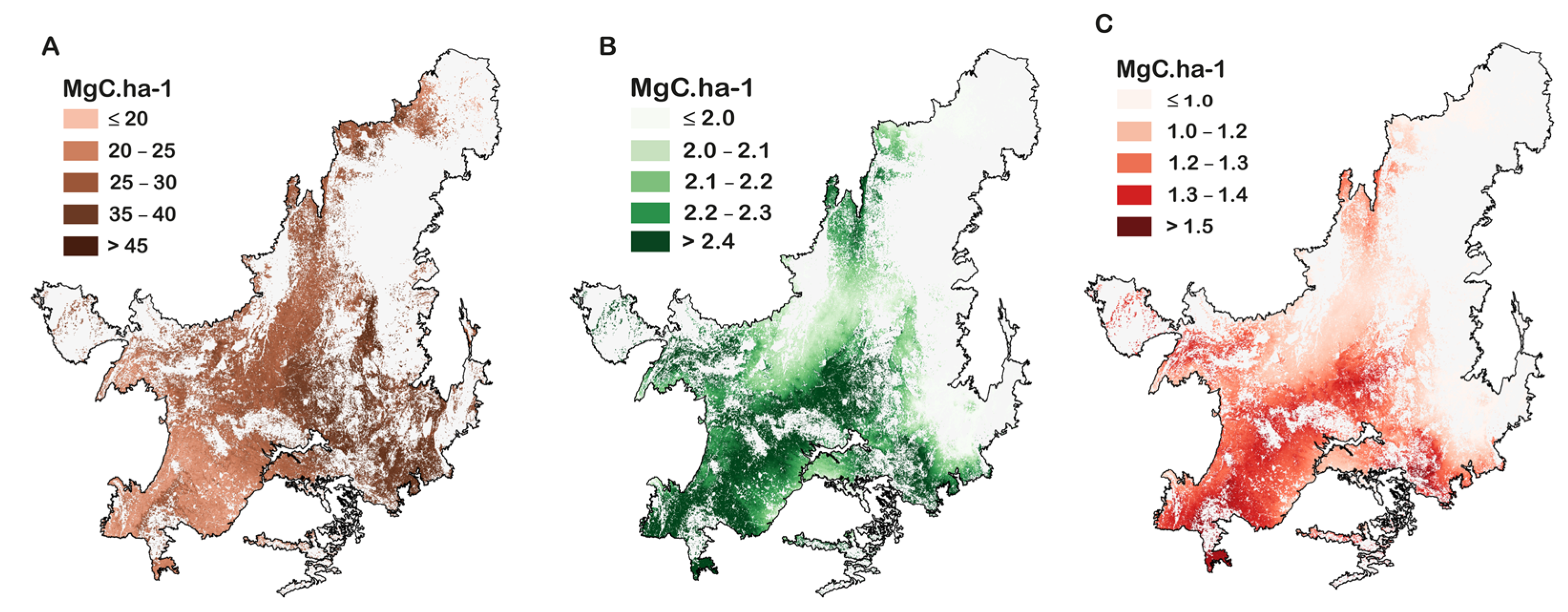

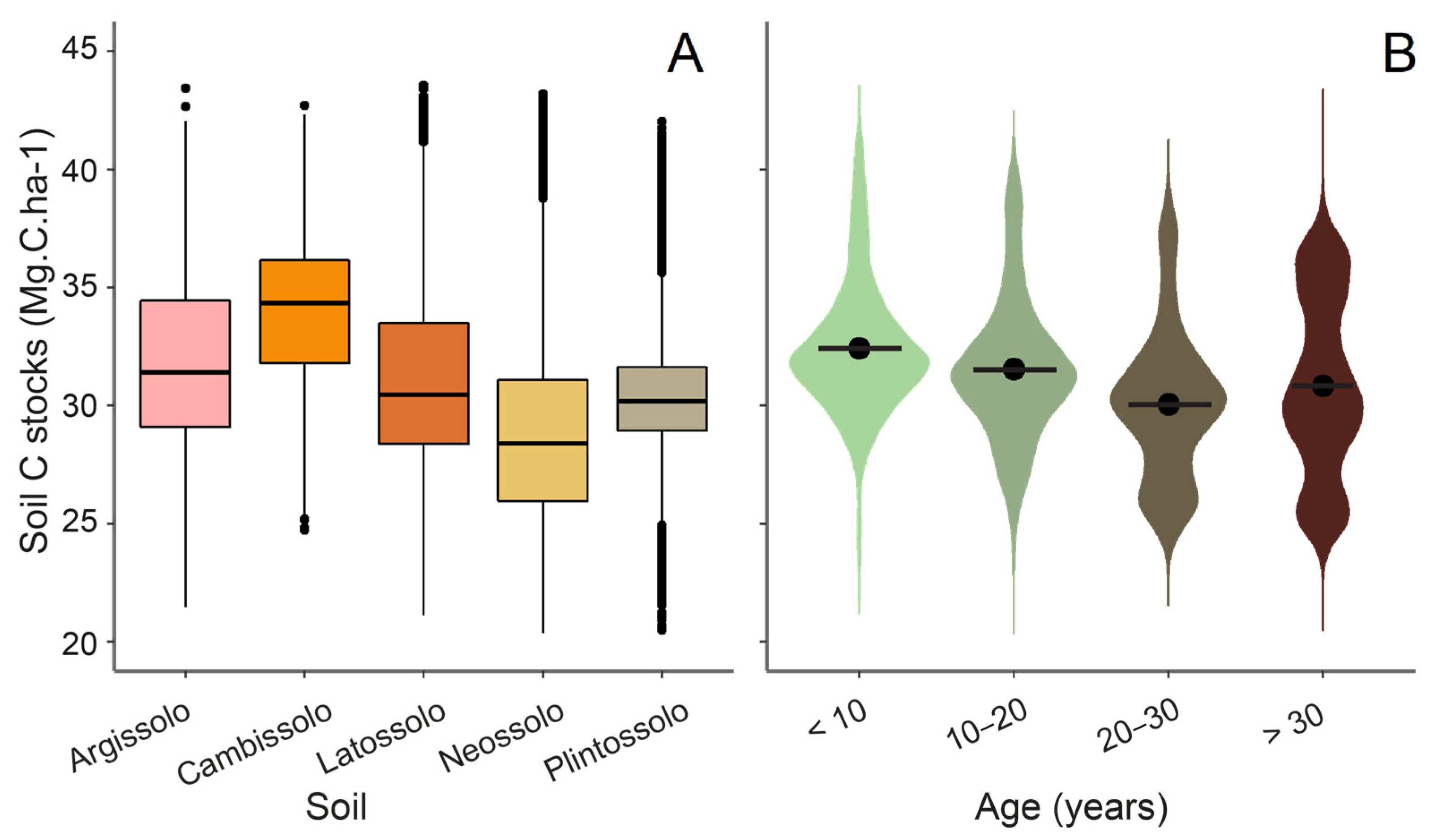
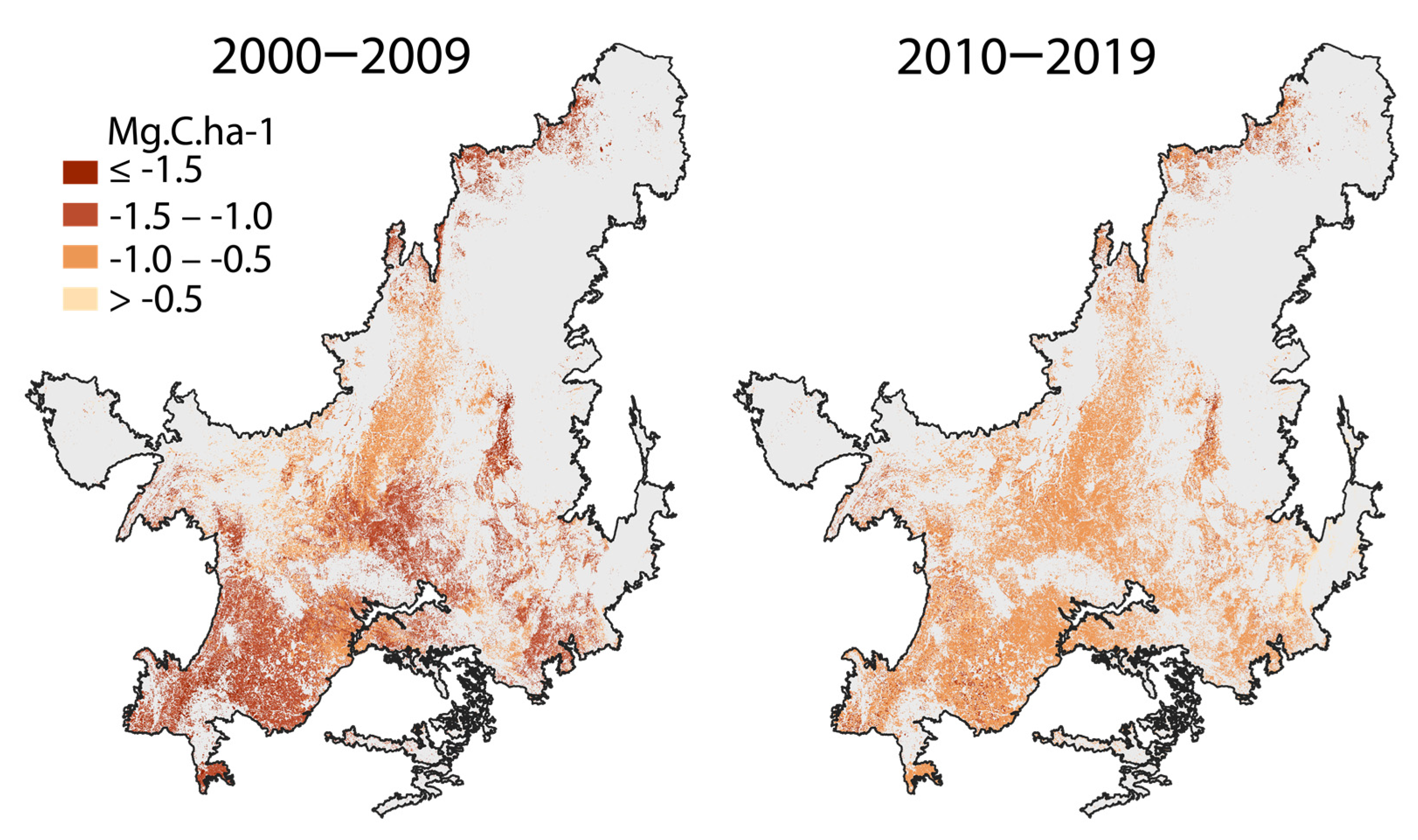
| Variable | Maximum | Minimum | Average | Standard Deviation |
|---|---|---|---|---|
| Sand (%) | 84.0 | 28.0 | 61.3 | 9.0 |
| Clay (%) | 52.0 | 9.0 | 23.6 | 6.2 |
| Silt (%) | 37.0 | 3.0 | 15.5 | 4.3 |
| pH KCl | 6.5 | 4.3 | 5.1 | 1.6 |
| Density (Kg/m3) | 1535.0 | 1137.0 | 1397.1 | 33.5 |
Disclaimer/Publisher’s Note: The statements, opinions and data contained in all publications are solely those of the individual author(s) and contributor(s) and not of MDPI and/or the editor(s). MDPI and/or the editor(s) disclaim responsibility for any injury to people or property resulting from any ideas, methods, instructions or products referred to in the content. |
© 2022 by the authors. Licensee MDPI, Basel, Switzerland. This article is an open access article distributed under the terms and conditions of the Creative Commons Attribution (CC BY) license (https://creativecommons.org/licenses/by/4.0/).
Share and Cite
Santos, C.O.d.; Pinto, A.d.S.; Silva, J.R.d.; Parente, L.L.; Mesquita, V.V.; Santos, M.P.d.; Ferreira, L.G. Monitoring of Carbon Stocks in Pastures in the Savannas of Brazil through Ecosystem Modeling on a Regional Scale. Land 2023, 12, 60. https://doi.org/10.3390/land12010060
Santos COd, Pinto AdS, Silva JRd, Parente LL, Mesquita VV, Santos MPd, Ferreira LG. Monitoring of Carbon Stocks in Pastures in the Savannas of Brazil through Ecosystem Modeling on a Regional Scale. Land. 2023; 12(1):60. https://doi.org/10.3390/land12010060
Chicago/Turabian StyleSantos, Claudinei Oliveira dos, Alexandre de Siqueira Pinto, Janete Rego da Silva, Leandro Leal Parente, Vinícius Vieira Mesquita, Maiara Pedral dos Santos, and Laerte Guimaraes Ferreira. 2023. "Monitoring of Carbon Stocks in Pastures in the Savannas of Brazil through Ecosystem Modeling on a Regional Scale" Land 12, no. 1: 60. https://doi.org/10.3390/land12010060
APA StyleSantos, C. O. d., Pinto, A. d. S., Silva, J. R. d., Parente, L. L., Mesquita, V. V., Santos, M. P. d., & Ferreira, L. G. (2023). Monitoring of Carbon Stocks in Pastures in the Savannas of Brazil through Ecosystem Modeling on a Regional Scale. Land, 12(1), 60. https://doi.org/10.3390/land12010060









